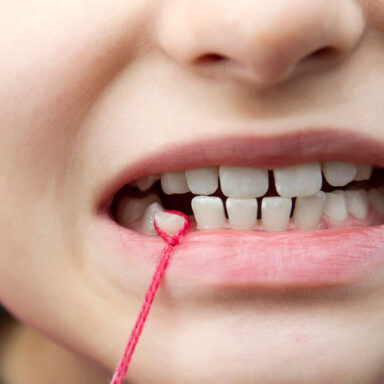Lexicon
Dysgnathia

Here you will find a simple explanation of the technical term dysgnathia and find out what types of dysgnathia there are and how it can be treated classically and alternatively.

Author
Dr. Fabian von Rom
Date
Estimated reading time
approx. 3 Min
Dysgnathia
Contents
What is dysgnathia?
The word dysgnathia is a medical term used to describe malpositions, malformations or deformities of the jaws. Dysgnathia is a skeletal deviation of the jaws from the norm. Both the upper and lower jaw can be affected by dysgnathia.
Some typical forms of dysgnathia are
- Retrognathia: Retraction of a jaw
- Prognathism: protruding jaw
- Micrognathia: jaw too small
- Macrognathia: jaw too large
- Laterognathia: jaw deviating to the side
- Skeletally open bite: jaws that have grown apart considerably at the front
- Skeletal deep bite: jaws strongly overgrown at the front
Dysgnathia is often accompanied by a disharmony or asymmetry of facial proportions. The reason for this is the skeletal imbalance. For example, retrognathia of the lower jaw can be recognized in profile by a receding chin. Prognathism of the lower jaw, on the other hand, is characterized by a protruding chin. The skeletal open bite is characterized by an enlarged lower third of the face. The skeletal deep bite is accompanied by a shortened lower third of the face.
Dysgnathia treatment with jaw surgery
In classic dysgnathia treatment, the deviation is treated at the jaw level. This is referred to as “combined orthodontic-jaw surgery” treatment. Such a treatment concept requires close cooperation between the two disciplines of orthodontics and oral surgery.
The oral and maxillofacial surgeon corrects the jaw misalignment by means of surgical measures. This part of the treatment is technically known as “corrective osteotomy”. As part of the combined orthodontic and maxillofacial dysgnathia treatment, the orthodontist uses braces to ensure that the upper and lower dental arches fit together harmoniously when the jaw position is corrected.
Alternative to jaw surgery for dysgnathia
For mild to moderate dysgnathia, dental compensation can be an alternative to surgical repositioning osteotomy. This type of treatment concept involves targeted tooth movement instead of surgically correcting jaw misalignment. For example, a large overbite caused by mandibular retrognathia can in some cases be concealed by moving all the upper teeth backwards. Because the underlying jaw misalignment still exists but is no longer so obvious, this type of dysgnathia treatment is also known as “camouflage treatment”.
Your expert for orthodontics
Dr. Fabian von Rom
In the specialist practice for orthodontics, Dr. med, dent. Fabian von Rom uses his extensive expertise and many years of experience to offer patients the best possible care. The practice offers the entire spectrum of modern orthodontics and specializes in innovative and advanced treatment methods. In addition to traditional procedures, the focus is on treatment with invisible braces for teenagers and adults – one of the most modern and discreet solutions in orthodontics. Dr. med. dent. Fabian von Rom attaches great importance to ensuring that medical precision goes hand in hand with a high level of patient satisfaction. By equipping the practice exclusively with individual treatment rooms, individual and professional care at the highest level is guaranteed.

Further topics
In our guide you will find lots more information on current, relevant and interesting topics relating to orthodontics. We hope you enjoy reading it!



